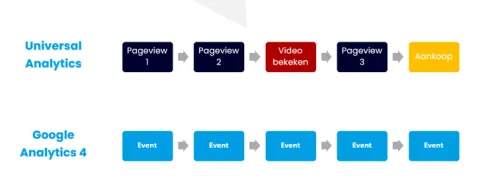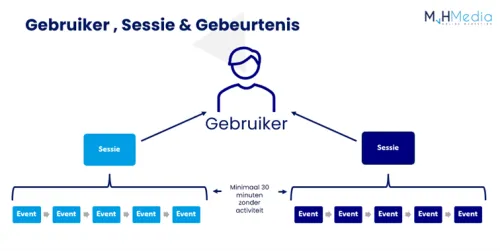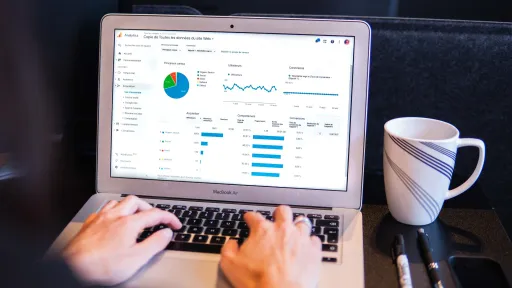The transition from Universal Analytics to Google Analytics 4 (GA4) has brought about a significant shift in how we perceive and analyze user behavior on websites and apps. A major change lies in the structure of acquisition data, moving from a session-based approach to a user-based approach. This transformation has required marketers and analysts to rethink how they interpret data for actionable insights.
Today, organizations are continuously optimizing the user experience on websites. Online visitors must be able to navigate the website in a user-friendly manner. Constantly loading new web pages does not contribute to this. As a result, more apps and one-page sites are being developed. For these sites, tracking sessions and page views is not relevant. Unlike Universal Analytics, GA4 now measures a series of events, with each event passing additional information to Google Analytics via parameters (see image below). This means Google has moved away from bounce rates, time on page, and pages per session to an event-driven data model.

Session-based Acquisition: The Traditional Approach
Historically, Google Analytics primarily operated based on sessions. Sessions are individual visits or interactions a user has with a website or app within a specific time period. Understanding which campaigns or channels drove immediate conversions or specific actions within a single session was the focus in older versions of Google Analytics. Marketers often used this data to optimize campaigns for immediate user actions or conversions and to measure the effectiveness of individual touchpoints.
User-based Acquisition: The Evolution in GA4
With the introduction of GA4, there is a shift towards a more holistic, user-centric approach. GA4 emphasizes understanding user journeys across multiple sessions and touchpoints rather than focusing solely on isolated sessions. User-based acquisition aims to provide an overall picture of user behavior. This allows marketers to analyze how users interact with a website or app over time and across different devices and touchpoints. GA4 achieves this by assigning a unique identifier to each user, allowing their journey to be tracked across multiple sessions, whether they are logged in or not. This enables marketers to gain insights into the entire user lifecycle.
To delve deeper into how GA4 processes this data, it's helpful to start with the basics. As is known, GA4 operates via an event-driven data model. These events (e.g., first_visit, session_start, purchase) occur within a specific session. Sessions can then be linked to a user. The image below illustrates this relationship:

To determine from which session each event originates, the session_start event generates a session ID, and Analytics associates the session ID with each subsequent event in the session. These sessions can be assigned to a user through a User ID. This forms the basis for how GA4 links sessions to users.
How a conversion (purchase) is then attributed to a specific traffic source can vary in GA4. In the image below, it can be seen that the purchase event occurred during the second session. When looking at the Traffic Acquisition report, it shows that Social/Organic is attributed as the source/medium for the conversion. When the User Acquisition report is consulted, Google/CPC is shown as the source/medium to which the conversion is attributed.

This can quickly lead to confusion. It is not uncommon for questions to arise in GA4 about how to interpret the user acquisition and traffic acquisition reports. How can online marketers easily handle this in practice? How can they see which channel generates the most traffic and which channel leads to the highest conversions? When it comes to the difference in reporting between user acquisition (user-based) and traffic acquisition (session-based), the distinction can be made as follows:
- User acquisition = the first traffic source that led a visitor to the website
- Traffic acquisition = the most recent traffic source that led a visitor to the website
Marketers must therefore be mindful that these reports need to be interpreted differently and determine which data is most relevant.
Why has GA4 adopted this more user-based approach? It offers several advantages:
- Detailed analysis of user journeys: Marketers gain deeper insights into how users interact with the website or app over time, providing insights into long-term behavior and preferences.
- Cross-device tracking: GA4's user-based approach allows for tracking users across devices, providing a more accurate picture of user behavior regardless of the device they use.
- Assessment of lifetime value (LTV): Analyzing user-based data facilitates the assessment of users' lifetime value, aiding in making better decisions about marketing strategies and budget allocation.
- Enhanced Personalization Capabilities: A holistic view of user behavior enables more accurate personalization strategies, tailoring experiences based on comprehensive user insights.
While user-based acquisition in GA4 provides valuable insights into long-term user behavior, session-based data remains relevant for understanding direct interactions and conversions within a session. It allows marketers to optimize both short-term conversions and long-term user engagement strategies by combining insights from both approaches.
Conclusion
Google Analytics 4 represents a significant shift from session-based acquisition to user-based acquisition, emphasizing understanding the complete user journey. By focusing on the user, GA4 provides marketers and analysts with more meaningful insights into user behavior over time. This evolution enables more informed decision-making, allowing businesses to create more personalized and effective marketing strategies to meet the ever-changing needs of their users.
```




